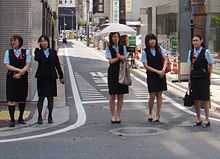Office lady

An office lady, often abbreviated OL, is a female office worker in China and Japan who performs generally pink collar tasks such as serving tea and secretarial or clerical work. OLs are often unmarried and live with their parents well into early adulthood. Office ladies are usually full-time permanent staff, although the jobs they do usually have little opportunity for promotion, and there is usually the tacit expectation that they leave their jobs once they get married.
Due to some Japanese pop culture influence in Hong Kong, the term is also in common usage there.
Often nicknamed shokuba no hana or "office flower", office ladies are usually hired right after high school or junior high, with university graduates discouraged from pursuing this type of career. They are kept around the office for the youth they bring to it, hence the "flower" nickname. They are charged with routine, menial tasks meant to support the male workers. This type of career offers very little chance of advancement and was specifically designed so that women would leave for marriage before their thirties. Women between the ages of twenty four and twenty eight often are advised to settle down as a subtle message to quit, as those years are considered the most suitable for marriage.[1]
History
The rise in OLs began after World War II, as offices expanded. They were first known as "BGs" (for Business Girls), but it was later found that English-speakers used a similar acronym, B-girls, to refer to "bargirls". Josei Jishin, a women's magazine, ran a competition to find a better name for the business girls. OL was chosen in 1963 from the entries.[2]
In the 1980s, being an OL was the most common job for Japanese women, and OLs made up approximately one-third of the female work force.[2]
According to Miyako Inoue, "The Equal Employment Opportunity Law (EEOL) was enacted in 1986, and phased into implementation. Although the EEOL had virtually no effect in changing discriminatory business practices, it was promoted nationally by the government..."[3]
In fiction
OL stock characters are frequently found in josei manga and anime, often portrayed as attractive, clever, and wistful individuals bored with their jobs, over-pressured by their families, and facing psychological issues.
- The Shomuni franchise includes manga, television series and films about office ladies.
- The manga and anime series Oruchuban Ebichu, for example, features an office lady character appropriately named OL.
- The warrior characters Linna Yamazaki (Bubblegum Crisis Tokyo 2040) and Arisa and Kyouko (All Purpose Cultural Cat Girl Nuku Nuku) have day jobs as office ladies.
- Most major characters in OL Shinkaron are office ladies.
- In Re: Cutie Honey, the titular Honey uses her OL job as a way to disappear from work without being noticed.
- Office Lady and Salaryman are Trainer classes in the original Japanese version of Pokémon Black and White, appearing in the commercial hub of Castelia City. They were renamed Clerk ♀ and Clerk ♂ (respectively) for the English versions of the game.
See also
References
- ↑ Imamura, Anne; Allison, Anne; Awaya, Nobuko; Lee Bernstein, Gail; R. Creighton, Millie; Ann Hastings, Sally; Lock, Margaret; Orpett Long, Susan; J. Marra, Robert; Mock, John; Lynne Rowland Mori, Barbara; A. Painter, Andrew; P. Phillips, David; S. Roberts, Glenda; R. Rosenberger, Nancy; G. Steinhoff, Patricia (1996). Re-imaging Japanese Women. Berkeley: University of California Press. p. 194. ISBN 0-520-20263-5.
- ↑ 2.0 2.1 Cherry, Kittredge (1987). "Office Flowers Bloom: Work Outside the Home". Womansword: What Japanese Words Say about Women (paperback) (First mass market edition, 1991 ed.). Tokyo: Kodansha International Ltd. p. 103. ISBN 4-7700-1655-7.
- ↑ Miyako Inoue. Vicarious Language: Gender and Linguistic Modernity in Japan. University of California Press, 2006, pg 171.
Further reading
- Ogasawara, Yuko (1998). Office Ladies and Salaried Men: Power, Gender, and Work in Japanese Companies. Berkeley, Calif.: University of California Press. ISBN 9780520210448. (subscription required (help)).
- Forrest, Jean (2001). "The Office Lady in Japan". Intext. Writing Program: Syracuse University.